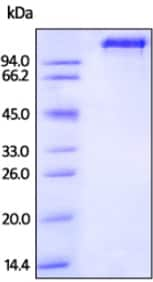Recombinant rhesus monkey EGFR protein (Fc Chimera Active) (ab208455)
Key features and details
- Expression system: HEK 293 cells
- Purity: > 95% SDS-PAGE
- Endotoxin level:
- Active: Yes
- Tags: Fc tag C-Terminus
- Suitable for: SDS-PAGE
Preparation and Storage
-
Alternative names
- Avian erythroblastic leukemia viral (v erb b) oncogene homolog
- Cell growth inhibiting protein 40
- Cell proliferation inducing protein 61
see all -
Function
Receptor tyrosine kinase binding ligands of the EGF family and activating several signaling cascades to convert extracellular cues into appropriate cellular responses. Known ligands include EGF, TGFA/TGF-alpha, amphiregulin, epigen/EPGN, BTC/betacellulin, epiregulin/EREG and HBEGF/heparin-binding EGF. Ligand binding triggers receptor homo- and/or heterodimerization and autophosphorylation on key cytoplasmic residues. The phosphorylated receptor recruits adapter proteins like GRB2 which in turn activates complex downstream signaling cascades. Activates at least 4 major downstream signaling cascades including the RAS-RAF-MEK-ERK, PI3 kinase-AKT, PLCgamma-PKC and STATs modules. May also activate the NF-kappa-B signaling cascade. Also directly phosphorylates other proteins like RGS16, activating its GTPase activity and probably coupling the EGF receptor signaling to the G protein-coupled receptor signaling. Also phosphorylates MUC1 and increases its interaction with SRC and CTNNB1/beta-catenin.
Isoform 2 may act as an antagonist of EGF action. -
Tissue specificity
Ubiquitously expressed. Isoform 2 is also expressed in ovarian cancers. -
Involvement in disease
Lung cancer
Inflammatory skin and bowel disease, neonatal, 2 -
Sequence similarities
Belongs to the protein kinase superfamily. Tyr protein kinase family. EGF receptor subfamily.
Contains 1 protein kinase domain. -
Post-translational
modificationsPhosphorylation at Ser-695 is partial and occurs only if Thr-693 is phosphorylated. Phosphorylation at Thr-678 and Thr-693 by PRKD1 inhibits EGF-induced MAPK8/JNK1 activation. Dephosphorylation by PTPRJ prevents endocytosis and stabilizes the receptor at the plasma membrane. Autophosphorylation at Tyr-1197 is stimulated by methylation at Arg-1199 and enhances interaction with PTPN6. Autophosphorylation at Tyr-1092 and/or Tyr-1110 recruits STAT3. Dephosphorylated by PTPN1 and PTPN2.
Monoubiquitinated and polyubiquitinated upon EGF stimulation; which does not affect tyrosine kinase activity or signaling capacity but may play a role in lysosomal targeting. Polyubiquitin linkage is mainly through 'Lys-63', but linkage through 'Lys-48', 'Lys-11' and 'Lys-29' also occurs. Deubiquitination by OTUD7B prevents degradation. Ubiquitinated by RNF115 and RNF126.
Methylated. Methylation at Arg-1199 by PRMT5 stimulates phosphorylation at Tyr-1197. -
Cellular localization
Secreted and Cell membrane. Endoplasmic reticulum membrane. Golgi apparatus membrane. Nucleus membrane. Endosome. Endosome membrane. Nucleus. In response to EGF, translocated from the cell membrane to the nucleus via Golgi and ER. Endocytosed upon activation by ligand. Colocalized with GPER1 in the nucleus of estrogen agonist-induced cancer-associated fibroblasts (CAF). - Information by UniProt
Images
-
Immobilized Recombinant human EGF protein (ab168895) at 10 μg/mL (100 μL/well) can bind ab208455 with a linear range of 39-625 μg/mL.
-
SDS-PAGE analysis of reduced ab208455 stained overnight with Coomassie Blue.
Note: DTT-reduced Protein migrates as 130-140 kDa in SDS-PAGE due to glycosylation..










